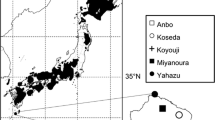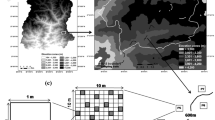Abstract
Dietary differences in the ages and sexes of Sika deer (Cervus nippon) were studied on Kinkazan Island, northern Japan from October 1990 to July 1991. Larger deer consumed more graminoids than smaller deer except in spring, and less dicotyledonous leaves in all the seasons. Fecal nitrogen concentrations were lower in larger deer than in smaller deer in all the seasons. The age-sex differences in foods were smaller in summer and winter when foods were most abundant and scarce, respectively, while they were greater in spring and autumn when food availability was intermediate.
Similar content being viewed by others
References
Anthony R. G. &Smith N. S. (1977) Ecological relationship between mule deer and white-tailed deer in southern Arizona.Ecological Monograph 47: 255–277
Beier P. (1987) Sex differences in quality of white-tailed deer diets.Journal of Mammalogy 68: 323–329.
Bell R. H. V. (1971) A grazing system in the Serengeti.Scientific American 225: 86–93.
Central Association of Livestock Industry (1975)Standard Chemical Compositions of Forages in Japan. Central Association of Livestock Industry, Tokyo (in Japanese).
Charmad A. D. &Box T. W. (1964) A point frame for sampling rumen contents.Journal of Wildlife Management 28: 473–477.
Charles W. N., McCowan D. &East K. (1977) Selection of upland swards by Red deer (Cervus elaphus) on Rhum.Journal of Applied Ecology 14: 55–64.
Clutton-Brock T. H. &Harvey P. H. (1983) The functional significance of variation in body size among mammals. In.Mammal Behavior and Ecology (ed. J. F. Eisenberg) pp. 632–668. Smithsonian Institute Press. Washington.
Clutton-Brock T. H., Iason G. R. &Guiness F. E. (1987) Sexual segregation and density-relared changes in habitat use in male and female red deer.Journal of Zoology, London 211: 275–289.
Geist V. (1974) On the relationship of social evolution and ecology in ungulates.American Zoologist 14: 205–220.
Gordon I. J. &Illius A. W. (1988) Incisor arcade structure and diet selection in ruminants.Functional Ecology 2: 15–22.
Hofmann R. R. (1973)The Ruminant Stomach: Stomach Structure and Feeding Habits of East African Game Ruminants. East African Monograph of Biology. East African Literature Bureau, Nairobi.
Hofmann R. R. (1989) Evolutionary steps of ecophysiological adaptation and diversification of ruminants: A comparative view of their digestive system.Oecologia 78: 443–457.
Illius A. W. &Gordon I. J. (1990) Variation in foraging behaviour in red deer and the consequences for population demographyJournal of Animal Ecology 59: 89–101.
Jarman P. J. (1974) The social organisation of antelope in relation to their ecology.Behaviour 48: 215–267.
Leslie D. M. Jr., Starkey E. E. &Vavra M. (1984) Elk and deer diets in old-growth forests in western Washington.Journal of Wildlife Management 48: 762–775.
McCullough D. R. (1985) Variables influencing food habits of white-tailed deer on George Reserve.Journal of Mammalogy 66: 682–692.
McCullough D. R., Hirth D. H. &Newhouse S. J. (1989) Resource partitioning between sexes in whitetailed deer.Journal of Wildlife Management 53: 277–283.
Putman R. J., Culpin S. &Thirgood S. J. (1993) Dietary differences between male and female fallow deer in sympatry and allopatry.Journal of Zoology, London 229: 267–275.
Shank C. C. (1982) Age-sex differences in the diets of wintering Rocky Mountain bighorn sheep.Ecology 63: 627–633.
Staines B. W. &Crisp J. M. (1978) Observation on food quality in Scottish Red deer (Cervus elaphus) as determined by chemical analysis of the rumen contents.Journal of Zoology, London 185: 253–277.
Staines B. W., Crisp J. M. &Parrish T. (1982) Differences in the quality of food eaten by red deer stags and hinds in winter.Journal of Applied Ecology 19: 65–77.
Stewart D. R. M. (1967) Analysis of plant epidermis in feces: A technique for studying the preference of grazing herbivores.Journal of Applied Ecology 4: 83–111.
Takatsuki S. (1980) Food habits of Sika deer on Kinkazan Island.Science Report of Tohoku University, Series IV (Biology) 38: 7–31.
Takatsuki S. (1983) The importance ofSasa nipponica as a forage for Sika deer (Cervus nippon) in Omote-Nikko.Japanese Journal of Ecology 33: 17–25.
Takatsuki S. (1986) Food habits of Sika deer on Mt Goyo, northern Honshu.Ecological Research 1: 119–128.
Takatsuki S. (1988) The weight contributions of stomach compartments of Sika deer.Journal of Wildlife Management 52: 313–316.
Takatsuki S. (1992a) Feeding ecology of ungulates. In:Modern Mammalogy (eds M. Asahi & T. Kawamichi) pp. 119–144, Asakura Publishing Company, Tokyo (in Japanese).
Takatsuki S. (1992b)Basic Studies on Sika Deer of Mt Goyo, III. Ofunato City, Ofunato, Iwate (in Japanese).
Warren R. J. &Krysl L. J. (1983) White-tailed deer food habits and nutritional status as affected by grazing and deer harvest managementJournal of Range Management 36: 104–109.
Watson A. &Staines B. W. (1978) Differences in the quality of wintering areas used by male and female Red deer (Cervus elaphus) in Aberdeenshire.Journal of Zoology, London 186: 544–550.
Weckerly F. W. &Nelson J. P. Jr. (1990) Age and sex differences of white-tailed deer diet composition, quality, and calcium.Journal of Wildlife Management 54: 532–538.
Whittaker R. H. (1952) A study of summer foliage insect communities in the Great Smoky Mountains.Ecological Monograph 22: 1–44.
Yoshii Y. &Yoshioka K. (1949) Plant communities of Kinkazan Island.Ecological Review 12: 84–105 (in Japanese).
Author information
Authors and Affiliations
About this article
Cite this article
Padmalal, U.K.G.K., Takatsuki, S. Age-sex differences in the diets of Sika deer on Kinkazan Island, northern Japan. Ecol. Res. 9, 251–256 (1994). https://doi.org/10.1007/BF02348411
Received:
Accepted:
Issue Date:
DOI: https://doi.org/10.1007/BF02348411




